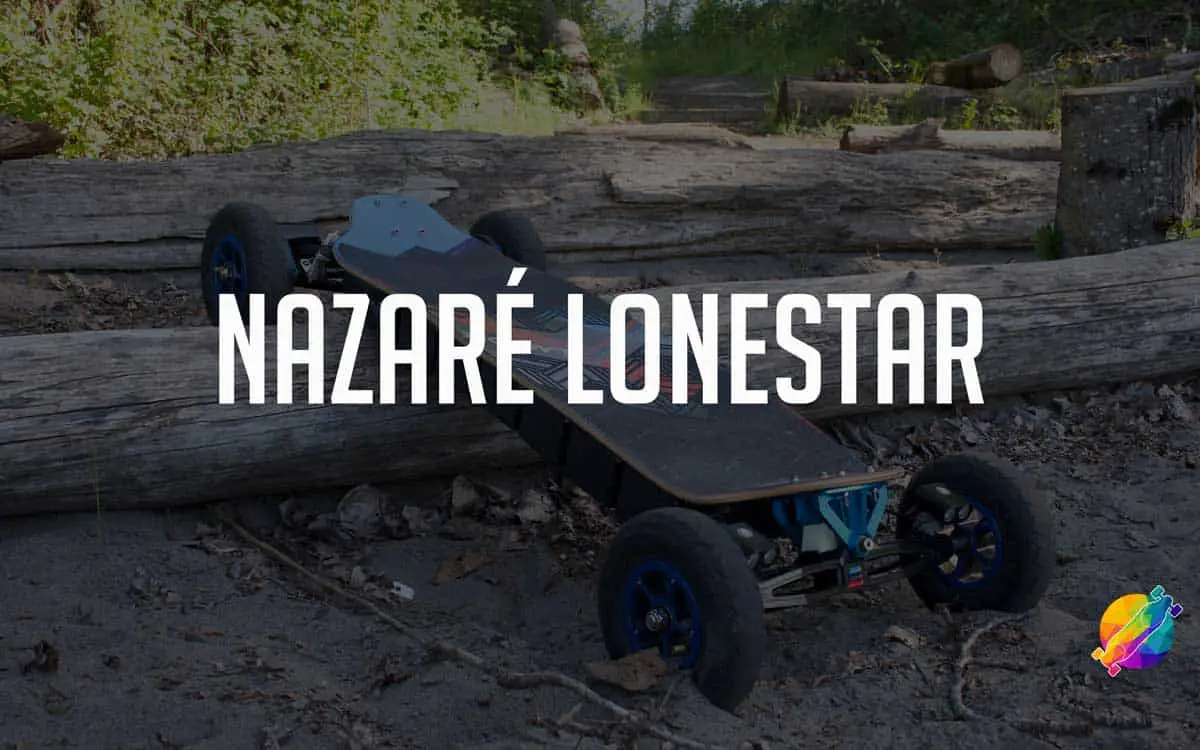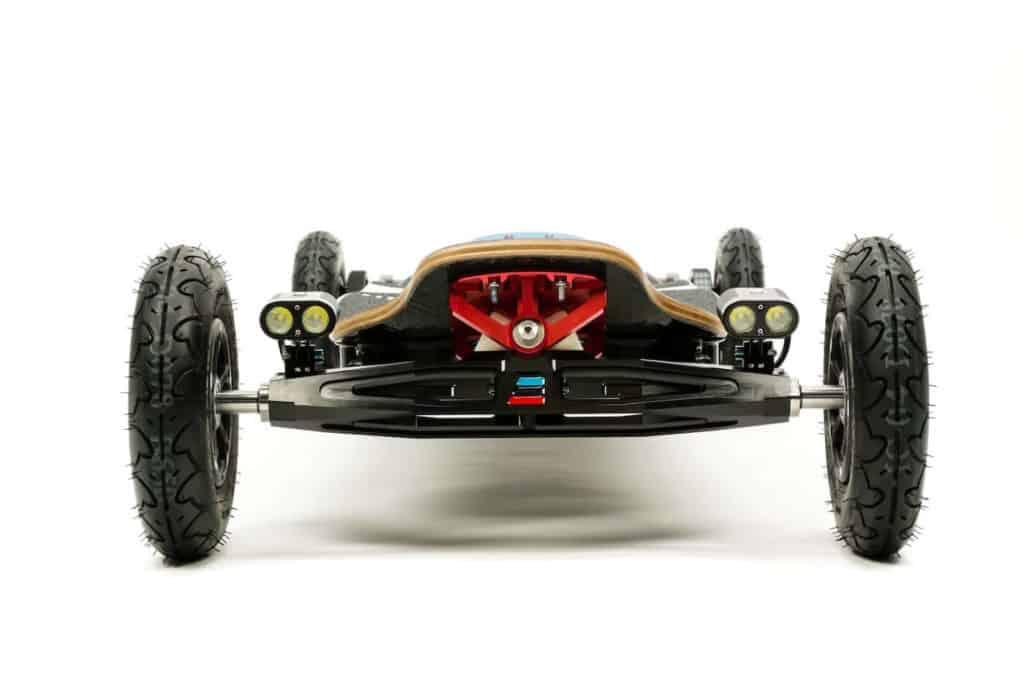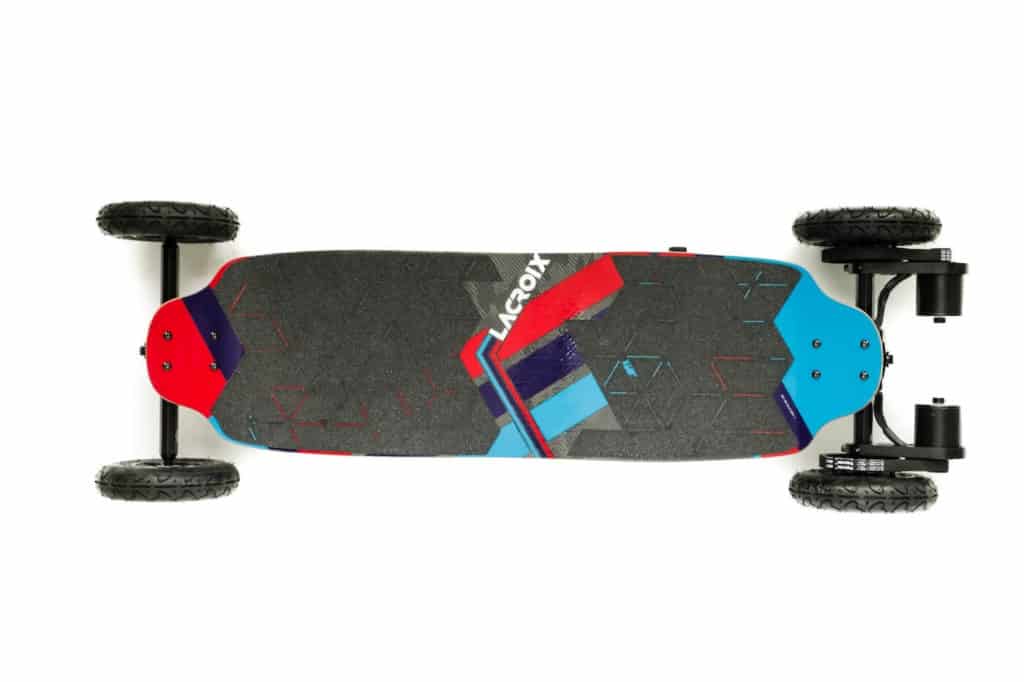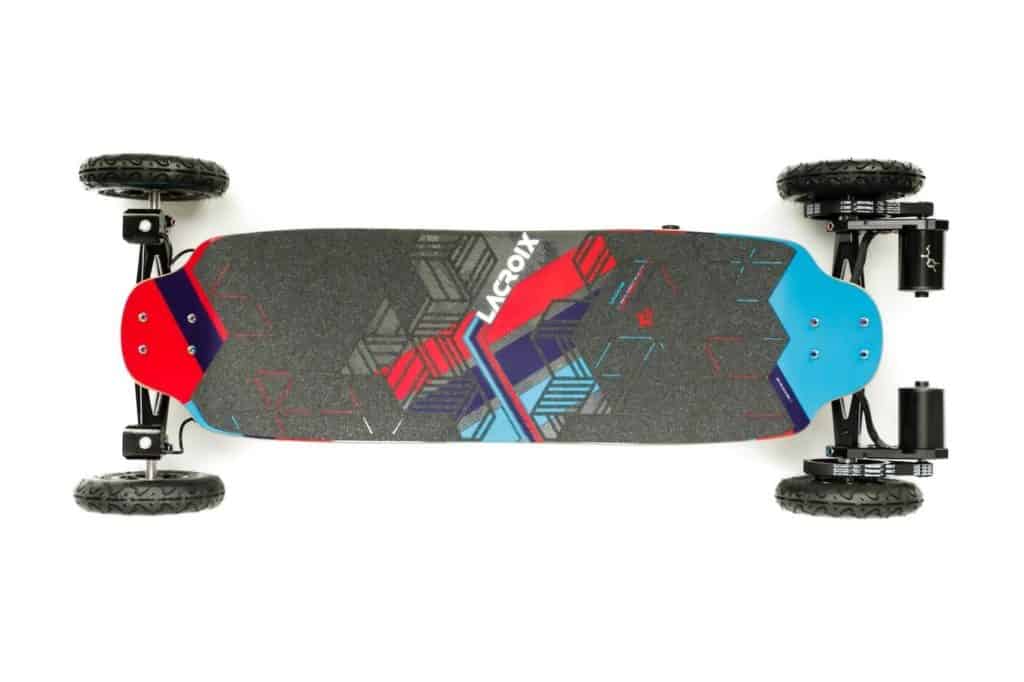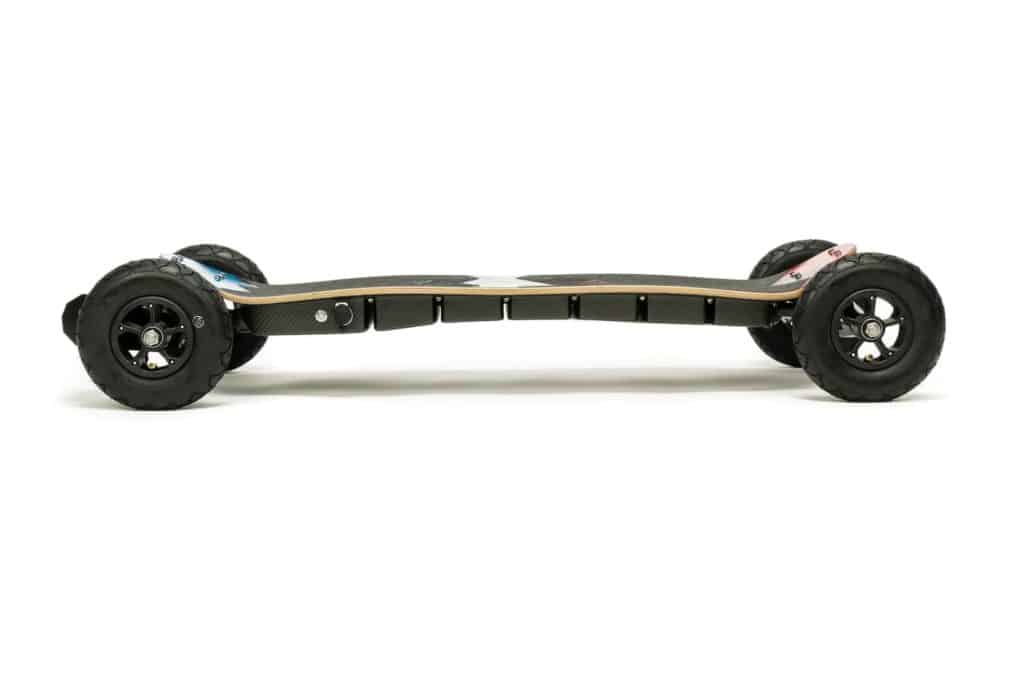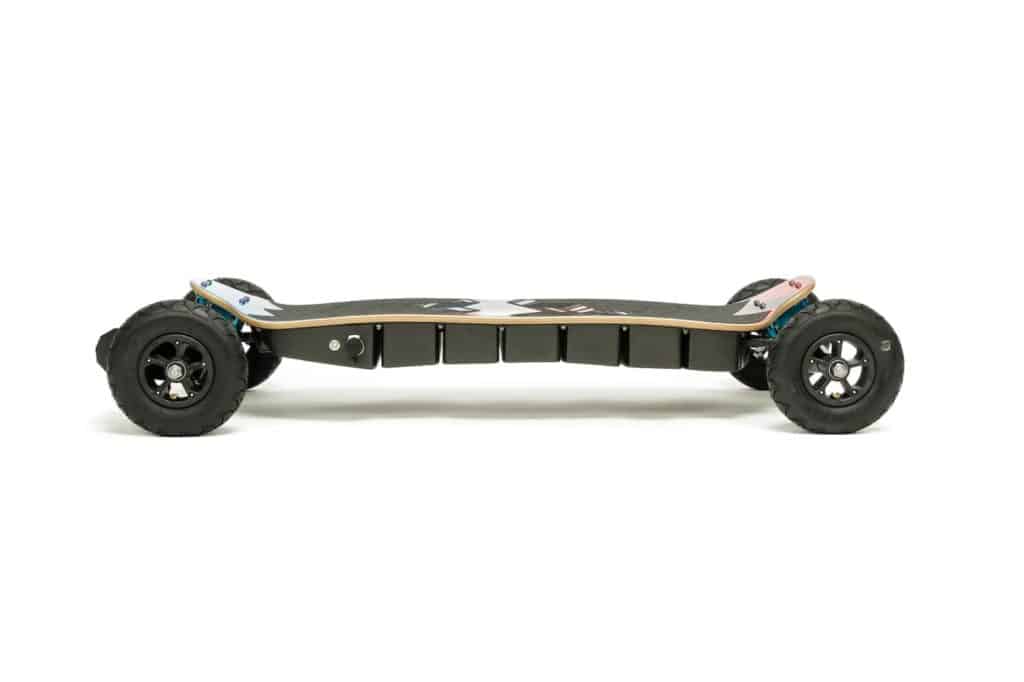The Nazaré Lonestar has set new standards in production electric skate equipment as the LaCroix team continues to relentlessly redefine what is possible. They won me over with the Prototipo as my introduction to 4-wheeled electric skateboarding. Now they have outdone themselves. This is the successor to that effort in every way, including comfort, performance, range, tune-ability, materials, and build quality. It is a different board and a much bigger board. All the hardware has been upgraded, but the LaCroix signatures remain, including comfy pneumatics and layers of Canadian maple and carbon fiber.

Lacroix Nazaré Lonestar Specs
| Motors | Dual 6389 – 190kv |
| Range | 50-60 miles |
| Max Speed | Unrated (with 18T motor pullies I saw 39mph) |
| Weight | 49lbs |
| Battery | 2178wh – 12s12p |
| Charge Time | 3.5 – 4 hours |
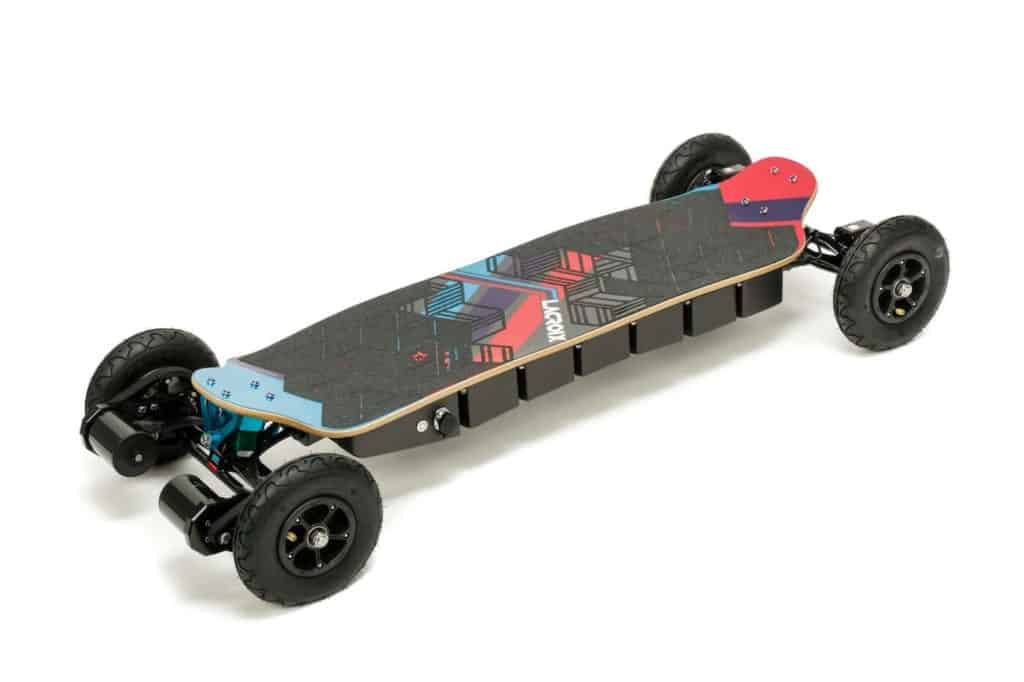
Check out the Nazaré Lonestar at Lacroix’ Website: lacroixboards.com/lonestar
Lacroix Jaws vs. Nazaré vs. Nazaré Lonestar
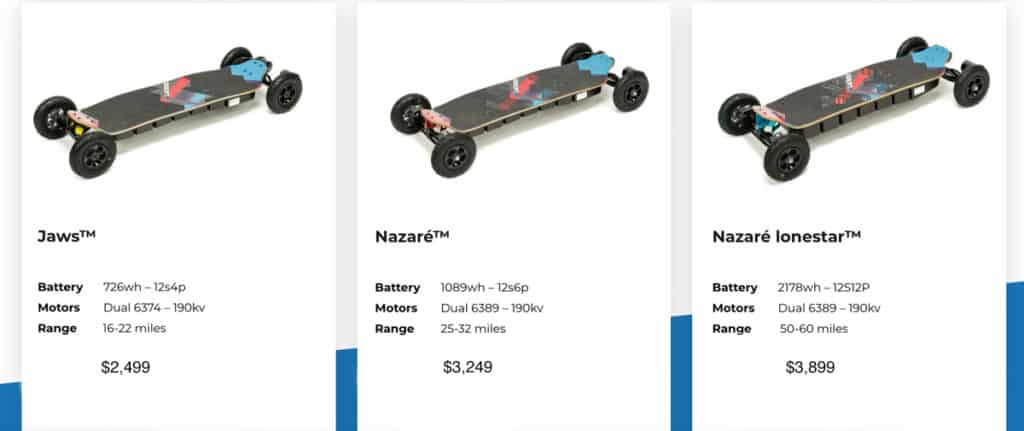
Jaws Nazaré Nazaré Lonestar
Jaws Nazaré Nazaré Lonestar
Jaws Nazaré Nazaré Lonestar
The Ride
The feeling of riding this board can be anywhere between standing on a fluffy plush magic carpet for a slow stroll and driving a Formula 1 car around a closed track for hours until your firesuit is drenched in sweat. In either case, wear a helmet! Control is smooth and effortless with LaCroix’s upgraded remote options and customizability via the Unity app. Each toe is independently tune-able at the trucks with the included multiple sets of bushings. Trying different settings at each toe is critical to getting the ride just right for one’s own style and speed preferences. I end up with something in the middle of loose and tight, as I like speed almost as much as deep carving. You can really lean into the carving too. LaCroix’s boards tend to correct themselves when you lean too hard or dig too deep in a carve, it is almost uncanny.
Remote(s)
As a matter of history, perhaps my only complaint about LaCroix’s original Prototipo was the remote. This has been resolved now with all their new boards including an improved default option, the Flipsky VX1 remote. Even better, you can check a box on the order page to upgrade to one of Hoyt St’s beautiful puck remotes for a fair price. I’ve only ever used a Hoyt puck remote with my LaCroix boards. I’m a strong believer in their multi-channel radio tech which has been flawless for 3500+ miles. The default throttle and brake feel is good, not too jumpy, and can be toned down by using modes 1&2 on the remote. For those wanting more specific refinements, you can use the Unity UI mobile app to tune the throttle and brake curves.
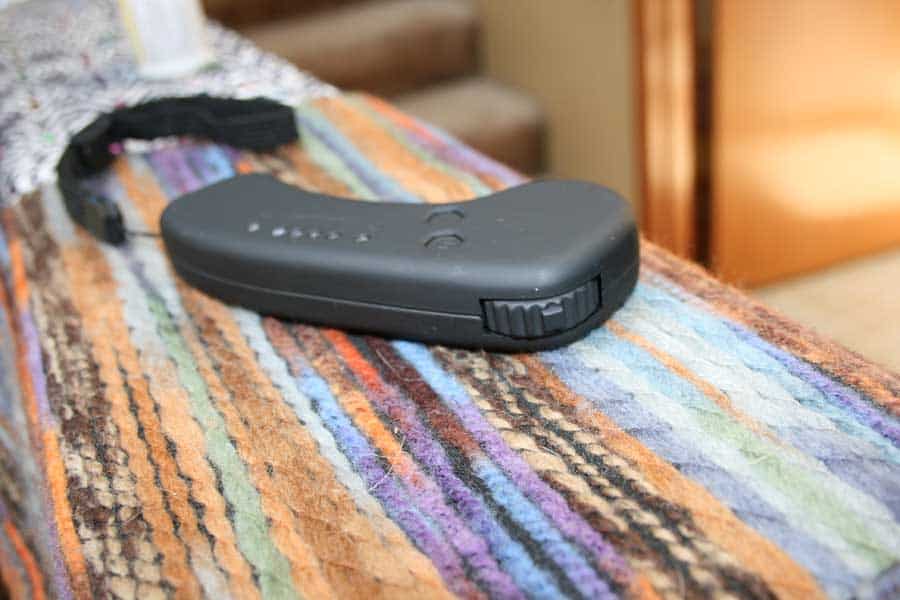

(This was a pre-production Hoyt puck, the black plastic they ship now doesn’t have these 3d printer lines.)

Top Speed – No one knows…
Speed comes so naturally to this board that it is easy to get carried away, especially if you swap in the included 18 tooth motor pulleys. I like to get carried away pretty often, so I wear a ton of gear (full street motorcycle setup). The absolute maximum with the faster pulleys for me is 39mph. I am running the stock medium-soft bushing configuration so I don’t spend a lot of time above 30mph.
Range? Just Ridiculous
The range is completely ridiculous on this board. With the tires inflated to a cushy 35psi and weighing about 195lbs with my gear I can achieve over 60 miles with ease, even on rides including really massive hills. On flatter ground with higher tire pressure and cruising slower, I’m confident I could get near 80 miles on a single charge.
Portability: Nope
Portability is not a feature. You’ll never be able to fly with it. It barely fits in some compact cars. It is a beast to carry around, at almost 50lbs. I guess the point of carrying 2KWH under your feet is that you have access to go wherever you need to while standing on top of the board.
The Build
I once described the Lonestar as “the best-made piece of equipment I’ve owned, ever”. I stand by this statement. It’s not because it was utterly perfect – I had to tweak some things and learn the maintenance routine – but because the most important details got the most obsessive attention at the factory and in their designs.
The Deck – ultrawide
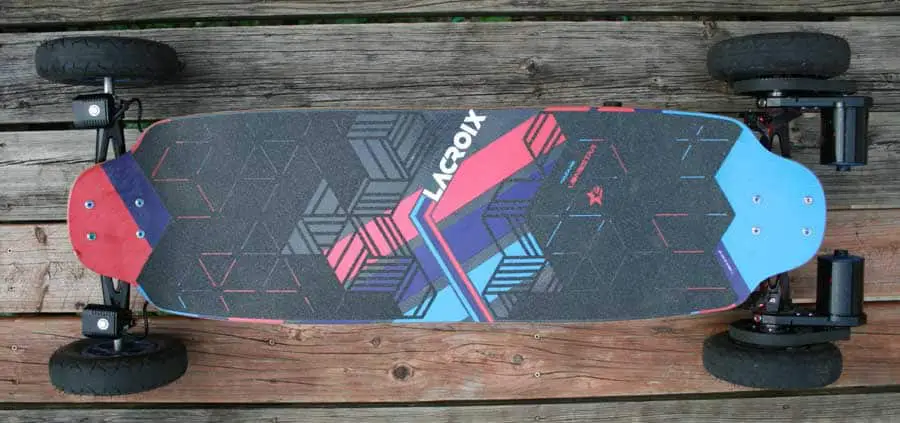
The deck design is a point of contention, for sure, when it comes to color choice. For some the factory deck style on the latest round of LaCroix boards is uniquely reminiscent of an 80’s Pepsi can. Personally, I like it. Looks aside, the stock grip tape is fantastically sticky, and the concave foot bowls and either end are definitely confidence-inspiring. Feels like a big safe boat that’s hugging my shoes rather than a sketchy plank I could slip off of. It is also durable – I had a spill in my first month of ownership and the board rammed into a chainlink fence hard but sustained only a couple of minor dents on the edge.
The Heart: Focbox Unity ESC
As of this writing, LaCroix is still working through a round of beta testing of its exciting new Stormcore ESC. For now the Nazaré and Lonestar are still shipping with Focbox Unity as the ESC, it is unclear if this will change at some point. I’ve been impressed with how smooth and reliable the Unity is, albeit a little bit nervous about the end of Enertion. My understanding is that LaCroix will stand by the hardware and provide support, regardless. The Unity simplifies the board’s configuration and adds efficiency to the platform over previous dual Focbox solutions.
The Battery – a Monster

The Lonestar battery is monstrous. It requires more vertical space that causes the deck to sit an extra 1.5 inches higher than the base model Nazaré with half the battery. To some this is a drawback. The inertia of the extra battery weight also seems to help keep the board planted and absorb some of the force of bumps while riding. With a massive included charger (12a) you can get the battery filled up pretty quickly, in 3.5 – 4 hours.

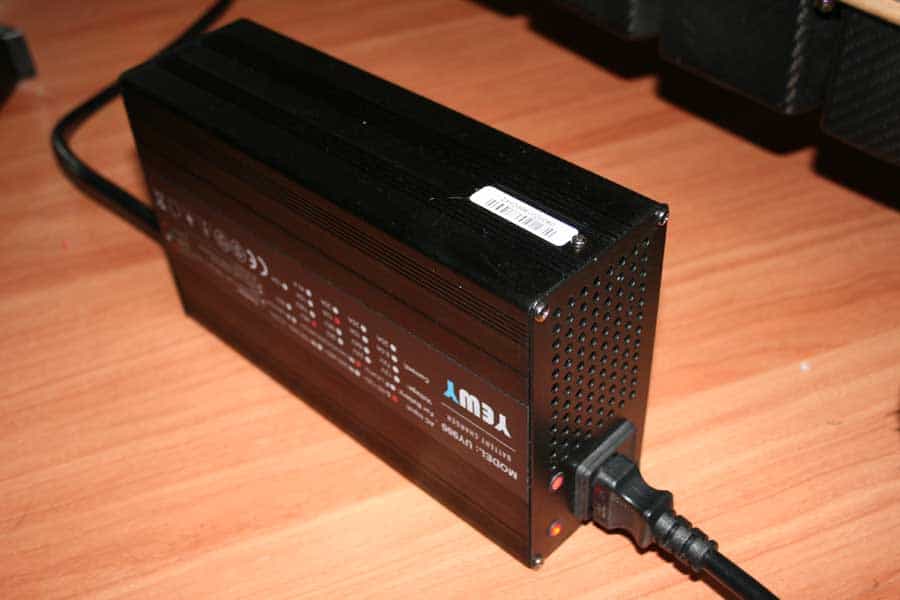
Lights? Super Bright and Integrated – Yes Please
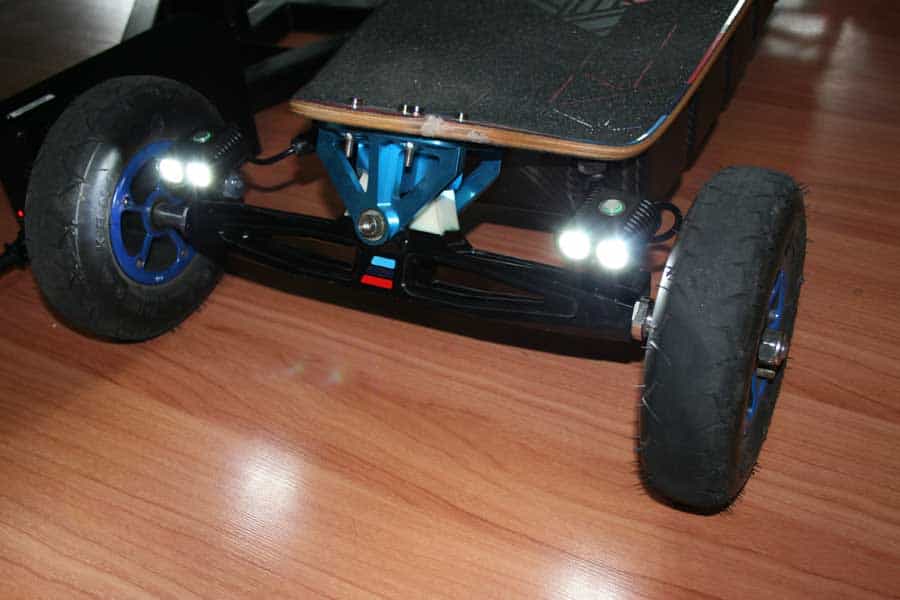
For those of us who like to go out hunting for open tarmac at night, it seems odd that any board would ship without integrated bright headlights. Thankfully LaCroix included super-bright headlights with this board. Careful, they have 4 settings, and even on #2 are so bright you may temporarily blind cyclists or pedestrians. They connect to the board’s onboard 12v circuit via nice water-resistant plugs of the same style as the charging plug, but smaller.
DIY Friendly

If you’ve ever tried to repair a Chinese-made mass-produced board or the battery, as I recently have, you’ll appreciate how well LaCroix’s internal and external components are designed, organized, and assembled. I tinker often and find it easy to add electric gadgets and to maintain the board mechanically. Inside the enclosure you’ll find lots of extra space for things like the factory-included GPS tracker, and my DIY battery gauge that I added to the board. I also noticed an unused 12v power port labeled “rear” on LaCroix’s main PCB and tapped into that for my brake lights mod. These were a great addition and now all my onboard light needs are powered by the main battery.
Waterproofing
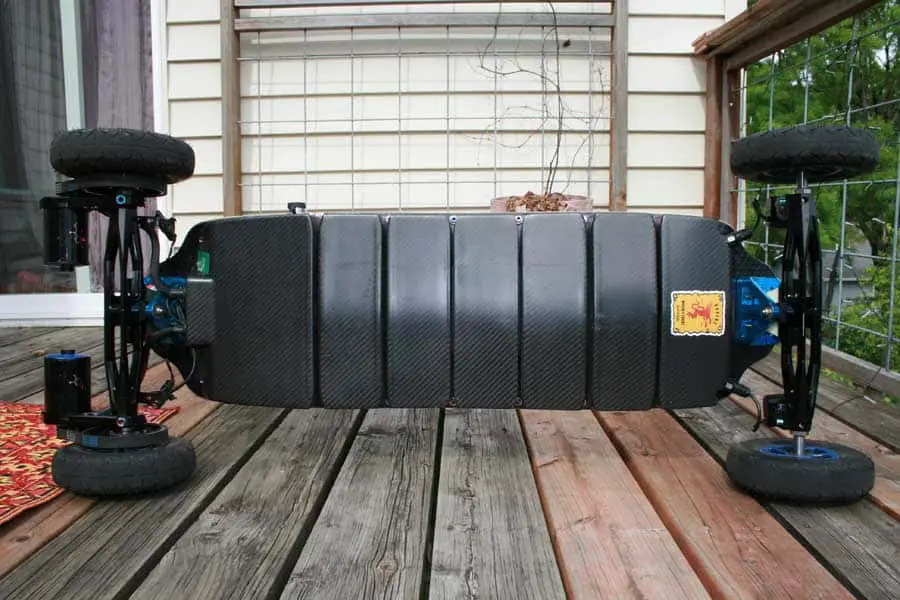
The enclosure is not waterproof, but it does have water-resistant seals. The main problem with getting the board a bit damp, in my experience, is that it can cause some rust between the bearings and axles both at the wheel and inside the motors. Not a problem until you need to do maintenance.
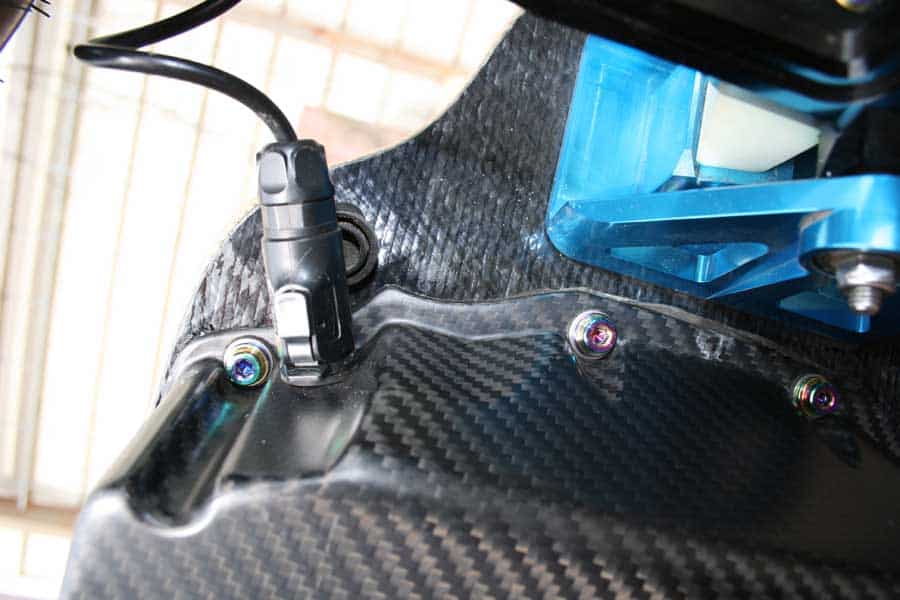
Drivetrain and Suspension
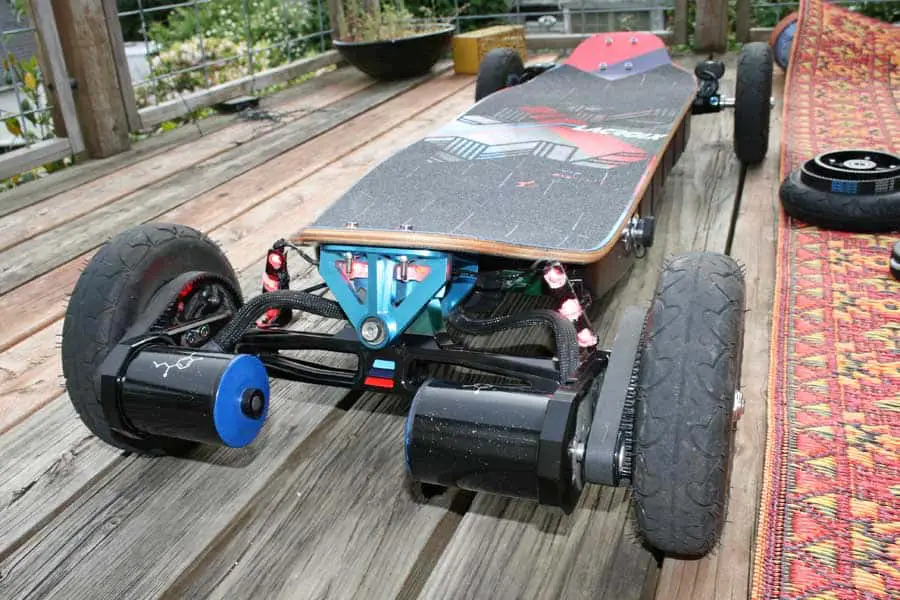
The massive motors sort of speak for themselves, lots of torque! WIth belts you can easily change your gearing, as motor pulleys can be swapped out in just a few minutes for more top end or low end. The board ships with more torque at the low end, using 16 tooth motor pulleys, but you can swap the included 18 tooth pulleys in for more at the top end. I LOVE the 18s, just recently switched. I’m happy with the belts, I don’t need to adjust them really ever, and the wear is manageable as I don’t ride much off-road.
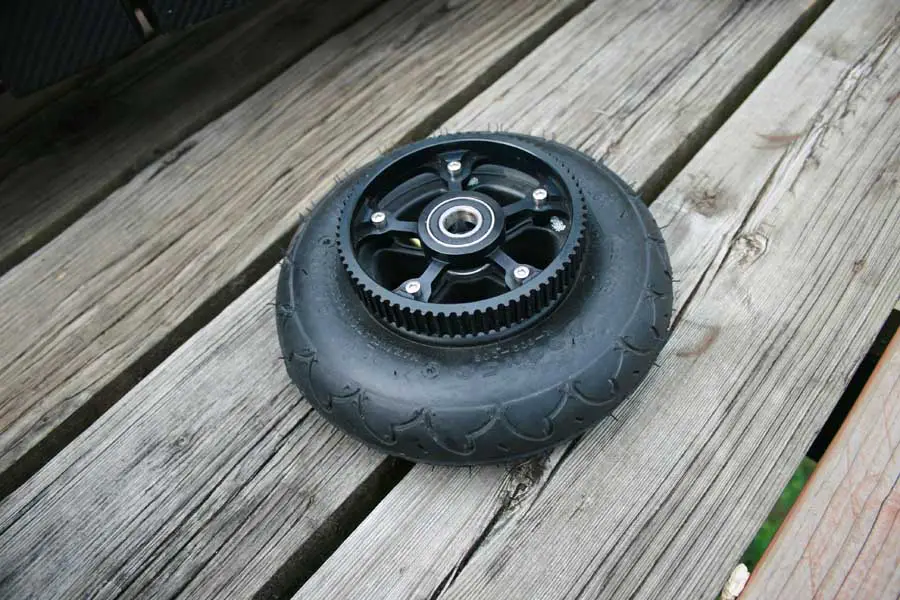
LaCroix has plans to offer a sealed gear drive which is to be fully backward-compatible (to Nazaré and Lonestar) later this year.
Lacroix Hypertrucks
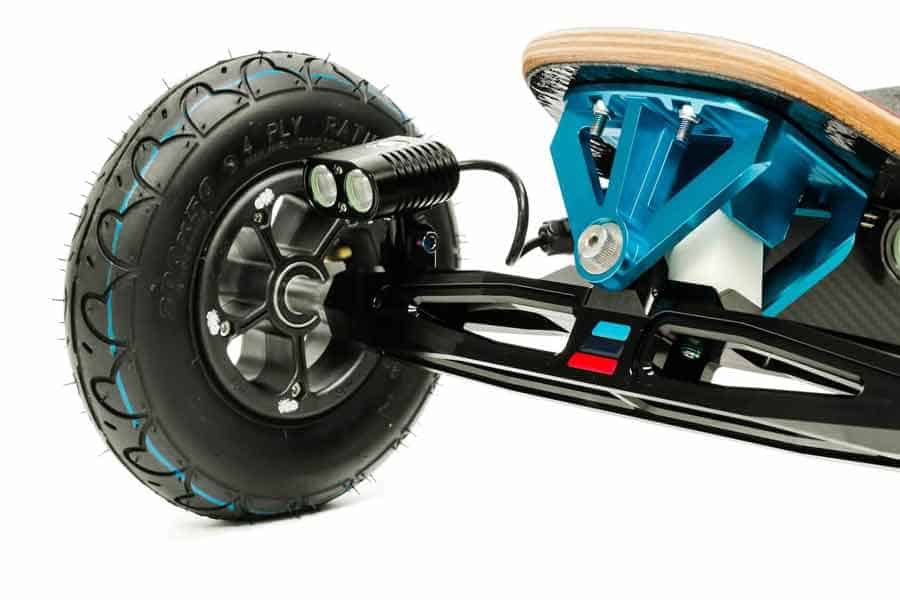
A big part of the cost of this board is the trucks. They are massive and made of surprisingly heavy and very durable aluminum. Stability and tune-ability are the driving force behind the design. By including several sets of bushings, each with different firmness, they set the rider up for finding exactly the right fit for one’s own style. It’s possible to nail either a super loose carving setup or a high-speed firm setup with equal accuracy, in my experience.
Customer Experience and Price
Shipping from LaCroix was prompt, but FedEx held my package for customs validation once it arrived in the US. It required a bunch of time and effort on my end. This was not LaCroix’s fault and I believe my situation was unique.
The team at LaCroix is ultra-responsive if you have any issues or questions, which I often do as a tinkerer. They have great customer service. They offer ongoing support for board tuning and configuration updates via YouTube videos.
At $4,000 the Lonestar is a massive outlay, few boards can top this price. But no other board can offer this ride and this range. So for me it was worth it.
All In one Lonestar
At the end of the day, I think about going for a ride. In the morning I wake up and think about going for a ride. This is the healthiest addiction I could have. I can ride further and with more confidence than ever. See you at the top of the tallest hill in town!

Check out the Nazaré Lonestar at Lacroix’ Website: lacroixboards.com/lonestar
